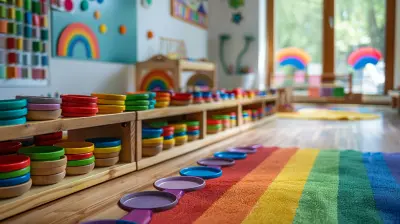4 June 2025
Teaching is one of the most fulfilling yet demanding professions out there. You’re not just an educator—you’re a mentor, a counselor, a problem-solver, and sometimes even a parent figure. But with all these roles combined, burnout can creep in before you even realize it.
So how do you keep your passion alive while maintaining your mental and emotional well-being? The answer is mindfulness. It’s not just a trendy buzzword—it’s a powerful tool that can help teachers stay grounded, reduce stress, and prevent burnout.
In this guide, we’ll explore how mindfulness can transform the teaching experience and provide practical strategies to integrate mindfulness into your daily routine.

What is Teacher Burnout?
Before we dive into mindfulness, let's talk about burnout. Teacher burnout is more than just feeling exhausted at the end of the day—it’s a prolonged state of physical, emotional, and mental exhaustion caused by chronic stress.Signs of Teacher Burnout
Not sure if you're experiencing burnout? Here are some common red flags:- Constant Fatigue – No matter how much you sleep, you always feel drained.
- Emotional Detachment – You start feeling disconnected from your students or the love you once had for teaching.
- Increased Irritability – Small things that never bothered you before now feel unbearable.
- Decreased Job Satisfaction – You start questioning whether teaching is even for you anymore.
- Frequent Illness – Stress weakens the immune system, making you more susceptible to illness.
Sound familiar? If so, don’t worry—there’s a way to regain balance and joy in your work. And that’s where mindfulness comes in.

What is Mindfulness?
Mindfulness is the practice of staying fully present in the moment without judgment. It’s about being aware of your thoughts, emotions, and surroundings—without getting overwhelmed by them.Think of your mind like a snow globe. When shaken (aka stressed), everything swirls around chaotically. But when you pause, breathe, and allow things to settle, clarity emerges. That’s mindfulness in action.

Why Mindfulness is Essential for Teachers
Bringing mindfulness into your teaching practice isn’t just about reducing stress. It can actually make you a better, more engaged educator. Here’s how:- Reduces Stress – Regular mindfulness practice lowers cortisol levels, helping you stay calm under pressure.
- Improves Emotional Regulation – It helps you manage difficult emotions, so you don’t take student behavior personally.
- Enhances Focus & Concentration – Mindfulness sharpens your attention, making it easier to stay present and engaged.
- Boosts Resilience – Challenges arise daily in a classroom, but mindfulness helps you bounce back instead of breaking down.
- Strengthens Relationships – A mindful teacher fosters a more positive, understanding, and patient classroom environment.

Simple Mindfulness Strategies for Teachers
Now that we know why mindfulness is crucial, let's get to the good part—how to incorporate it into your daily routine!1. Start Your Day with Intention
Instead of rushing into the day with a chaotic to-do list, take a moment each morning to set an intention.Try this:
- Before stepping into your classroom, take three deep breaths.
- Ask yourself, What kind of teacher do I want to be today?
- Set a simple intention like I will be patient or I will focus on the joy of teaching.
You’ll be surprised how something so small can shift your entire mindset.
2. Practice Mindful Breathing
When stress hits, your breathing often becomes shallow without you even realizing it. Mindful breathing can quickly bring you back to the present.Try this:
- Stop whatever you're doing.
- Take a deep breath in through your nose for four counts.
- Hold for four counts.
- Exhale slowly through your mouth for four counts.
- Repeat a few times until you feel more grounded.
This exercise takes just a few seconds but can help you reset in the middle of a hectic day.
3. Take a Mindful Pause Between Classes
Transitions between classes can feel chaotic, but a quick mindfulness moment can help you reset.Try this:
- Before greeting your next class, close your eyes for a few seconds.
- Take a deep breath and release any tension from the previous lesson.
- Mentally remind yourself, Each class is a fresh start.
This can prevent stress from compounding throughout the day.
4. Create a Mindful Classroom Atmosphere
Your students feed off your energy. If you’re stressed, they’ll feel it. But if you cultivate a mindful classroom environment, everyone benefits.Try this:
- Begin class with a short breathing exercise.
- Introduce a "quiet minute" before or after major transitions.
- Encourage students to pause and take a breath before answering tough questions.
By weaving mindfulness into the classroom, you’re not just helping yourself—you’re teaching students lifelong coping skills.
5. Practice Gratitude at the End of the Day
It’s easy to dwell on the tough moments of the day, but shifting your focus to gratitude can change everything.Try this:
- Before leaving school, write down three things that went well.
- Reflect on a positive interaction with a student.
- Remind yourself of why you became a teacher in the first place.
Gratitude rewires the brain to focus on the good, reducing stress and increasing job satisfaction.
6. Set Boundaries with Work
Teachers often bring work home, blurring the line between professional and personal life. But to prevent burnout, boundaries are essential.Try this:
- Set a strict cutoff time for grading and lesson planning.
- Resist the urge to check work emails outside school hours.
- Prioritize self-care without guilt—because a well-rested teacher is a better teacher.
7. Use a Mindfulness App
If you're new to mindfulness, guided meditations can be a great place to start. Apps like Calm, Headspace, and Insight Timer offer short, easy-to-follow mindfulness exercises perfect for busy teachers.Try this:
- Listen to a 5-minute meditation before or after work.
- Use a nighttime relaxation exercise to help with sleep.
Even a few minutes of mindfulness each day can make a significant difference.
Final Thoughts
Teaching is a marathon, not a sprint. Without mindfulness, the daily stress can pile up, leading to burnout and frustration. But by integrating small, intentional mindfulness practices into your routine, you can reclaim your peace, passion, and joy for teaching.So take a deep breath. Give yourself grace. And remember—you can’t pour from an empty cup. Prioritize your well-being, and everything else will fall into place.








Idris Romero
Mindfulness for teachers? Finally, a way to find zen amidst the chaos of grading, snack-stealing students, and the eternal question: ‘Can I go to the bathroom?’ Let's breathe deeply and conquer the classroom like Jedi!
November 14, 2025 at 11:55 AM